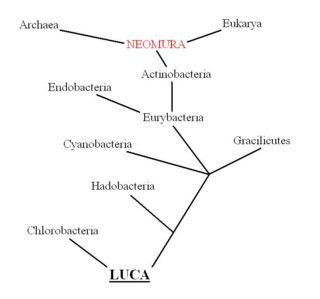Neomura: Difference between revisions
Jump to navigation
Jump to search

imported>Michael McClellan No edit summary |
imported>Michael McClellan No edit summary |
||
| Line 6: | Line 6: | ||
| subdivision = | | subdivision = | ||
[[Archaea]]<br> | [[Archaea]]<br> | ||
[[Eukarya]] | |||
}} | }} | ||
'''Neomura''' is the domain containing the two subdomains of [[Archaea]] and [[Eukaryota]]. According to [[Thomas Cavalier-Smith]], the distinction between Neomura and [[Bacteria]] was marked by twenty evolutionary adaptions, which accompanied, or derived from, two other important adaptions: the development of [[histone]]s to replace [[DNA gyrase]], and the loss of [[peptidoglycan]] [[cell wall]]s to be replaced by other [[glycoprotein]]s. The word "Neomura" reflects this last change; it means "new walls." | '''Neomura''' is the domain containing the two subdomains of [[Archaea]] and [[Eukaryota]]. According to [[Thomas Cavalier-Smith]], the distinction between Neomura and [[Bacteria]] was marked by twenty evolutionary adaptions, which accompanied, or derived from, two other important adaptions: the development of [[histone]]s to replace [[DNA gyrase]], and the loss of [[peptidoglycan]] [[cell wall]]s to be replaced by other [[glycoprotein]]s. The word "Neomura" reflects this last change; it means "new walls." | ||
[[image:Neomuratree.JPG|thumb|left|320px|A phylogenetic tree, showing how Eukaryota and Archaea are more closely related to each other than to [[Bacteria]], based on [[Cavalier-Smith]]'s theory of bacterial evolution.]] | [[image:Neomuratree.JPG|thumb|left|320px|A phylogenetic tree, showing how Eukaryota and Archaea are more closely related to each other than to [[Bacteria]], based on [[Cavalier-Smith]]'s theory of bacterial evolution.]] | ||
Revision as of 18:49, 26 March 2007
| Neomura | ||
|---|---|---|
| Scientific classification | ||
| ||
| Subdomains | ||
Neomura is the domain containing the two subdomains of Archaea and Eukaryota. According to Thomas Cavalier-Smith, the distinction between Neomura and Bacteria was marked by twenty evolutionary adaptions, which accompanied, or derived from, two other important adaptions: the development of histones to replace DNA gyrase, and the loss of peptidoglycan cell walls to be replaced by other glycoproteins. The word "Neomura" reflects this last change; it means "new walls."

A phylogenetic tree, showing how Eukaryota and Archaea are more closely related to each other than to Bacteria, based on Cavalier-Smith's theory of bacterial evolution.